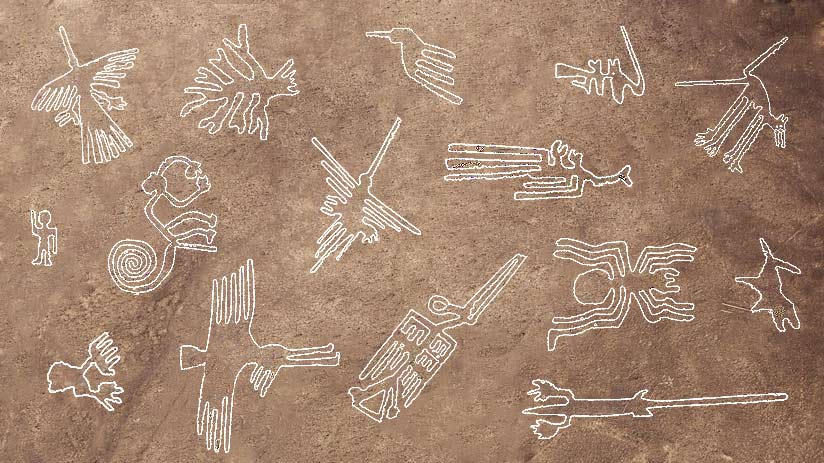Trapezoids, triangles and many other geometric shapes — that’s what one would see if they flew a drone over the high desert in Peru, South America. These giant geometric figures resemble birds, insects and other living beings.
These are the famous Nazca lines which were discovered in the 1920s. In total, there are over 800 straight lines and 300 geometric figures. Archaeologists have been studying these lines ever since their discovery and still continue to do so till date.
In the last decade or so, researchers from Japan’s Yamagata University alone have discovered more than 100 new geoglyphs. Now, they have joined hands with tech giant IBM to make use of artificial intelligence and identify geoglyphs more efficiently.
Ever since their discovery, these geoglyphs have been subject to many theories. While few archaeologists connect the dots between astronomical observations and lines, the others spark up theories on aliens and other supernatural forces.
Studying these etchings from the ground is difficult, and this hampered the research in their early days. Today, researchers from around the world work for years to identify the hidden markings on the land.
How AI Plays A Role
A research team led by Professor Masato Sakai (Cultural anthropology, Andean archaeology) at Yamagata University discovered 142 new geoglyphs which depict people, animals and other beings, at the Nazca Pampa.
The biomorphic geoglyphs are thought to date back to at least 100 BC to AD 300. Additionally, in a feasibility study carried out from 2018 to 2019 together with IBM Japan, the university discovered one new geoglyph by developing an AI model on the AI server IBM Power System AC922 configured with the deep learning platform IBM Watson Machine Learning Community Edition (formerly known as IBM PowerAI).
AI Speeds Up The Process
Nazca lines in Peru are one of those discoveries that spark out various conspiracy theories ranging from aliens to supernatural beings. This specific region in Peru got its reputation for having mysterious etchings on the land, the enormity of which, could be realised using a drone or trekking up a hill.
Ever since their discovery in the 1920s, these drawings or geoglyphs as they are named, have been under the scanner to decipher the ancient thought processes and other secrets. While previous methods have taken many years, using AI, the researchers could do it in two months.
The geoglyph spotted by AI tools is a human figure about five meters (16 feet) tall. IBM Japan Scientists from Japan have used machine learning for the first time to identify a new figure among the ancient motifs of Peru’s Nazca Lines.
The illustration, known as a geoglyph, is thought to date to between 100 BC and 500 AD, and was made by removing the dark stones of the Nazca Desert to reveal the white sand beneath.
It is small, just five meters in height (shown above), and it shows a humanoid figure grasping a cane or club. Like the other drawings in the Nazca Desert, its exact function is unknown, but its discovery next to an ancient path suggests it might have been used as a waypoint. It is in an area that we often investigated, but we did not know the geoglyph existed.
So far, satellite-based or drone-based remote hyperspectral sensing and imagery have helped researchers discover hundreds of these figures.
Today scientists are looking to work more efficiently and improve their ability to find and study new geoglyphs. For this, researchers from Yamagata joined hands with IBM to make use of IBM PAIRS Geoscope platform and AI.
PAIRS GEOSCOPE is a platform, specifically designed for processing massive geospatial-temporal data (maps, satellite, weather, drone, IoT). This platform was also used for crop identification, irrigation management, as well as monitoring vegetation growth around power lines to reduce the risk of outages.
IBM made its platform widely available in February, and its customers have already begun to use it to help improve how multiple sources of data can be integrated to benefit large-scale operations.
Uncovering the formations at the Nazca is a difficult task. The above picture is what an aerial shot of one region in Peru looks like. Unless suggested, it is difficult to identify the presence of any geometric figure.
So. identifying usually takes years but with the help of IBM, researchers could do the same in a few months.
For Yamagata’s research, the geoscope and AI offer the unique ability to analyse massive datasets from a number of sources, including layers of LiDAR data along with drone images, satellite visuals and geographical survey information, to help reveal new lines and formations.
Conventional archaeological practices would require a significantly longer time to integrate different types of data, potentially adding months to the discovery process.
With PAIRS, these same tasks and analyses are expected to take minutes.
Future Direction
The exact purpose of the geoglyphs is still unknown. When the American professor Paul Kosok was investigating these geoglyphs back in the 1940s, he caught the sunset to be in direct alignment with the line. Kosok called the 310 square mile stretch of the high desert “the largest astronomy book in the world”.
Later, the German, Maria Reiche, studied these lines for 40 years and fought unyieldingly for her theories on the lines’ astronomical and calendrical purpose. She had to battle it out to save the site from destruction for lack of awareness.
Ancient art is a window into the culture and methods of our ancestors and preserving such sites becomes crucial as the on-site research usually takes decades of study.
By imbibing deep learning algorithms into archaeological studies, the researchers hope to speed up the process and uncover more mysteries.












































































